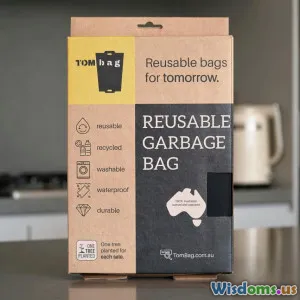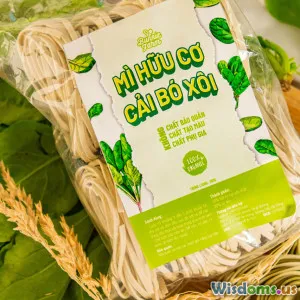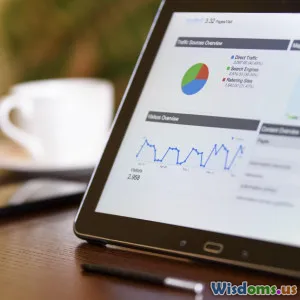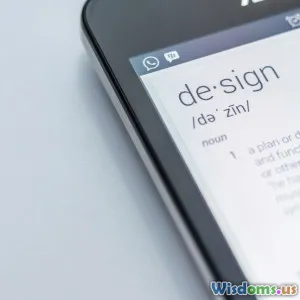
EcoFriendly Packaging That Looks Great And Saves Money
13 min read Discover how eco-friendly packaging can combine aesthetics and cost-efficiency for businesses, delighting customers while saving money and supporting the environment. (0 Reviews)
Eco-Friendly Packaging That Looks Great And Saves Money
Introduction: When Saving the Planet Means Growing Your Business
Picture this: You receive a package in the mail and, instead of layers of difficult-to-recycle plastic and excessive fillers, you find a cleverly designed, biodegradable box wrapped with a minimalist, stylish label. The unboxing experience feels special, thoughtful, and sustainable.
Recently, eco-friendly packaging has shifted from a niche concern to the center stage of business operations. It's more than just a green checkbox—it’s an opportunity for brands to stand out, connect with eco-conscious consumers, and slash unnecessary costs. Yet, a lingering myth persists: that “going green” means compromising on design or spending more.
Let’s bust that myth. In this article, you’ll discover how smart businesses create eco-friendly, beautiful packaging – and actually spend less in the process. We'll explore leading trends, practical strategies, and inspiring real-world success stories that will transform the way you look at packaging.
Why Eco-Friendly Packaging Matters: Beyond the Buzzwords
The Stakes for Brands and the Planet
Packaging accounts for nearly 40% of global plastic demand and is a major driver in landfills, waste management nightmares, and ocean pollution (UN Environment Programme, 2023). As Gen Z and Millennials make up a growing share of consumers, expectations for ethical business practices—and packaging—are rising fast.
But it’s not just about public relations. Consider these key insights:
- 83% of consumers among younger generations are willing to pay more for sustainable packaging (Trivium Packaging 2023 Global Buying Green Report).
- 68% of businesses adopt sustainable packaging initiatives now—not to follow regulation, but to strengthen their brand and customer loyalty (McKinsey & Company, 2023).
- Companies shifting to green packaging frequently cut shipping, material, and inventory costs.
Rethinking Packaging: Core Principles
Before diving into visually stunning examples and savings, let’s clarify: What makes packaging truly eco-friendly?
- Material Sourcing: Use renewable, recycled, or biodegradable substances (e.g., FSC-certified paper, mushroom-based foam, plant-based plastics).
- Minimalism: “Right-size” designs reduce material, filler, and waste.
- Ethical Supply Chains: Transparent, fair trade, and energy-efficient production.
- Circularity: Packages designed for reuse, recycling, or composting at end of life.
- Efficient Logistics: Lightweight, stackable, and space-efficient to lower transportation emissions and costs.
Adhering to a mix of these principles is the foundation. But can eco-friendly choices also delight customers—and save you money?
The Aesthetics: Style in Sustainability
From Drab to Fab—How Eco Packaging Becomes Brand Art
Early “green packaging” often brought to mind uninspired, bland cardboard boxes. Today, that’s ancient history. Brands now use sustainable materials as a design feature, not a compromise.
Example: Lush Cosmetics—Bare Beauty, Bold Identity
Lush, known for natural bath and body products, leverages plain, recycled cardboard and minimalist text. Product labels double as branding—no plastic sleeves, no excess glitter. This “unprocessed” look is both an environmental statement and a bold branding move.
Example: Seed Phytonutrients—Shower-Ready Yet Paper-Based
Seed Phytonutrients packages its shampoos in waterproof, recyclable paper bottles, utilizing textured, earthy tones to evoke an artisanal, organic image. This tactile approach creates a unique consumer experience and encourages display rather than discard.
Tip: Use Natural Beauty
- Neutral color palettes with water-based inks emphasize eco-credentials
- Exposed textures (embossed kraft paper, molded pulp) feel premium
Customization: Make Sustainable Look Luxurious
With digital printing and innovative folding, companies can skip plastic wraps and still deliver a “wow” factor:
- Custom-cutting logos or windows into packaging, revealing product while reducing ink needs.
- Drawstring closures with hemp twine—both reusable and elegant.
- Seed-embedded paper: Packaging that literally grows wildflowers when composted!
Cost-Effective Sustainability: Where Savings Are Hiding
Myth: Green Packaging Is Always Pricier
Fact: While the initial per-unit material cost for eco-friendly options may be slightly higher, holistic cost analysis often reveals substantial savings:
- Reduced Volume & Size: Lighter, right-sized boxes slash both material and shipping costs. One audit by UPS found that using 20% smaller boxes with minimal filler saves up to 15% on freight costs per shipment.
- Fewer Packaging Components: Streamlined, minimal designs skip trays, wrapping, or inserts—passing direct savings to the bottom line.
- Bulk Material Sourcing: Commitment to high-volume recycled cardboard can yield discounts from suppliers keen to encourage sustainability.
- Tax Incentives and Partnerships: Many governments or industry groups now offer grants for companies that shift to sustainable packaging.
Case Study: Dell’s Mushroom Magic
When technology giant Dell began shipping laptops using mushroom-based molded packaging, they achieved:
- 80% smaller carbon footprint vs. petroleum foam
- Cheaper disposal (compostable on site), saving landfill fees
- Enhanced brand image, with zero consumer complaints about damage in transit
Big Picture: Fewer Returns, More Loyalty
A less considered but massive financial saving? Customer satisfaction. Damaged goods and clunky packaging are top causes of returns. Protecting products well with smarter sustainable materials reduces these costs. There’s also a “halo effect:”
“After our shift to minimal, recycled packaging, customer reviews shot up 20%—people love telling friends about our eco mission,” reports Maya Yu, COO of direct-to-consumer electronics brand Groovv.
Sourcing, Designing, and Implementing Great Sustainable Packaging
Material Innovations: What’s Possible Today?
- Molded Pulp: Made from recycled fibers, it’s lightweight, shock-absorbent, and compostable. Used by Apple and countless e-commerce brands.
- Biodegradable Poly Mailers: Cornstarch or PLA blends decompose, unlike plastic. Groupe Beneteau ships boat parts worldwide in these.
- Glassine Paper: Translucent, water, and grease-resistant—ideal for bakery goods or textiles. Compostable.
- Mycelium (Mushrooms) and Seawood Packaging: Lightweight, literally grown in custom molds, and nutrients for soil at end of life.
Supplier Selection: Smart Sourcing Reduces Waste
Not all “sustainable” suppliers are equal. Consider:
- Do they hold certifications? (FSC, Cradle to Cradle, Compostable logo)
- Can they provide life-cycle analysis or data about true end-of-life recovery?
- Are regional suppliers available to minimize shipping emissions?
Creative Collaboration: Working With Designers
The best sustainable designs begin with an open conversation between marketers, engineers, and graphic designers:
- Keep packaging graphics minimal but informative, spotlighting eco-friendly logos
- Explore single-color/integral printing (less ink, high impact)
- Integrate user feedback: What complaints or delights do customers share about packaging?
Regulatory Landscape: Proactive or Reactive?
Stay ahead of legislation:
- The UK Plastic Packaging Tax (2022) penalizes non-recycled plastic use.
- EU’s Single Use Plastics Directive eliminates polystyrene for many applications.
- The US is moving state-by-state; Colorado’s Producer Responsibility Law (2024) is the latest, requiring companies to fund end-of-life solutions.
Those who proactively adopt eco packaging now stay future-proof and avoid costly regulatory scrambles.
Branding and Storytelling: Turning Sustainability Into Engagement
The Rise of “Unboxing” as Marketing
Unboxing videos rack up millions of views annually on platforms like YouTube and TikTok. Beautiful, unique—and sustainable—packaging now amplifies word-of-mouth excitement for products:
Example: ByHumankind—Minimal Boxes, Maximum Change
This sustainable personal care company prints bold messaging inside their packages, describing the journey and afterlife of their packaging. Brands can request customers share their packaging stories using a specific hashtag—yielding free advertising.
Transparency and Claims: Avoid “Greenwashing”
Cautious customers are more educated now. They look for clear, third-party certifications, specifics rather than vague claims like “eco-friendly.”
Actionable approach:
- Use icons/certifications visible on the packaging
- Reference exact materials and end-of-life (e.g., “100% home compostable, certified by TUV Austria.”)
Connecting with Purpose-Driven Shoppers
When values are visible, loyalty follows: “Knowing a tiny seed-embedded card will flower in my garden made me feel a part of the brand’s mission,” says Rachel, a frequent buyer from Seedlip Drinks.
Real-World Successes: Brands Winning with Eco-Friendly Packaging
Patagonia: Simplicity That Sells
The outdoor clothing brand eliminated all unnecessary fillers, switched to recycled polybags, and replaced elaborate printing with subtle messaging about sustainability. Despite spending 10% less per unit on packaging, sales rose—thanks to enhanced credibility among their eco-focused audience.
Unilever’s “Loop” Partnerships
Unilever has piloted circular models via TerraCycle’s “Loop” program: products shipped in reusable, collect-and-refill containers. Costs per shipment are lower overall for repeat customers, dramatically cutting single-use waste.
Amazon’s Frustration-Free Packaging (FFP)
Amazon’s FFP incentivizes suppliers to use recyclable, easy-to-open designs. Since launch, FFP:
- Removed 1 million tons of packaging (2009-2023)
- Saved over $2.6 billion in operational costs
Useful reference: Amazon’s Sustainability Initiatives
Getting Started: Steps to Transform Your Packaging for Sustainability and Savings
-
Audit Current Packaging
- Weigh all materials by SKU
- Note returns, damages, complaints, and shipping costs
-
Define Sustainable Goals
- Set % recycled content, reduction targets, or certifications to meet
- Publicly commit (even modestly!) to involve your customers
-
Research and Test Alternatives
- Order samples or pilot options for promising materials
- Work with designers for creative, “on-brand” sustainable finishes
-
Educate and Empower Staff
- Open channels for frontline workers and customers to suggest packaging improvements
- Share why and how changes align with the company’s mission
-
Track Results and Tell Your Story
- Share savings, positive impacts, or challenges with your audience regularly
- Celebrate milestones with your customer community to spark advocacy
Conclusion: Eco-Friendly Packaging Is a Win-Win, Not a Compromise
Sustainable packaging is no longer a luxury, nor a branding afterthought—it’s a catalyst for customer happiness, loyalty, and bottom-line growth. With so many innovative materials and design approaches now available, eco-friendly packaging can be stylish, protective, share-worthy, and affordable all at once.
Forward-thinking brands—from Patagonia to local Etsy shops—are proof that investing in earth-friendly packaging isn’t just the right thing to do: It’s a smart business move. The question is no longer "Should we go green?”, but rather, “How quickly can we make packaging a core asset for savings and brand success?”
Now’s the time to rethink, redesign, and revolutionize.
If you’re a business owner, entrepreneur, or creative, the transformation starts with your very next package.
Rate the Post
User Reviews
Popular Posts
















